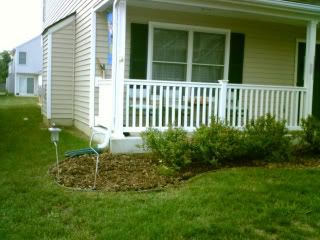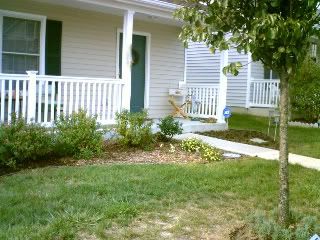Before I can even consider turning this dirt patch into a raised garden bed I need to mix organic material into the clay soil – preferable compost. Fortunately, sneaky person that I am I have a big ol’ composter making some fertilizer for me by way of a garbage can I made into a compost bin that fully complies with my Homeowner’s Association Rules. My first batch of compost came out well. After feeding the Covert Urban Composter food scraps all winter it was time to check how much Gardner’s Gold I had to work with this spring.
I mosey on over to the compost bin in the backyard. I take a look. I see this.
I get grossed out.
After some research I discovered that this yellow spongy, foamy and phallic looking blob is a slime mold. Specifically, Dog Vomit Slime Mold .
Aptly named don’t you think?
Dog Vomit Slime mold (gosh you just don’t get to type that several times in one sitting do you?) usually develops in damp, shady areas where there is a lot of decaying organic matter like soggy flower beds that use bark mulch.
This makes perfect sense because we’ve had a very rainy Spring. When I took the lid off of the compost bin everything was water logged. There was slime mold all over the top and sides of my compost. And boy did it ever stink! Bad.
How Do You Get Rid of Dog Vomit Slime Mold?
Easy. You don’t.
First off Dog Vomit Slime mold is not harmful to people, plants, or pets. In fact, some people in Mexico eat slime mold.
No thanks, I’ll pass.
It’s lifecycle is very short. When slime mold first appears it’s usually bright yellow and can grow as it chows down on the decaying wet leaves and whatnot (legend has it that slime molds were the inspiration for the kitschy 1958 sci-fi movie The Blob.) Next, the slime mold turns light brown and finally dries into dark, powdery spores. The whole process can take a couple of hours or a couple of days.
If this slime mold grew in the mulch in my flower beds I could just leave it and it would go away on its own. In this case I was advised to throw the moldy compost out.
Oh and just to you gross you out a little further, when I emptied the bin I found a nice big family of maggots in my compost.
Yummy.
Once the compost bin was empty I was told to clean it with either bleach (no thanks) or hydrogen peroxide (yes, please.) I mixed up a solution of hydrogen peroxide based “oxygen” bleach and water and used that to clean the compost bin inside and out, including the lid. I let the clean bin dry in the sun.
I emailed Gardener's Supply Ask an Expert and asked them how I could prevent my compost from molding again. This is what they said.
If you're developing mold in your compost pile it certainly sounds like the materials are too wet most of the time. Drilling more aeration holes would definitely help the ability of the pile to receive more air and should keep the materials more dry. Too much moisture will drown the microorganisms, and too little will dehydrate them. A general rule of thumb is to keep the material in your compost pile as moist as a well-wrung sponge.To make sure that I didn’t have moldy, soggy, maggoty compost again, I drilled more aeration holes in the bottom and sides of the Covert Urban Compost Bin. This last batch of compost was mostly kitchen scraps so I’m going to concentrate on adding more paper from my paper shredder for "browns." I’m also going to ask the lawn service to leave the grass clippings on our lawn so I can rake them up and put them in my compost bin. Oh, and this time I’ll try to turn the compost more often because last time I didn’t mix my compost at all - oops.
To do their work most efficiently, microorganisms require a lot of oxygen. When your pile is first assembled, there will probably be plenty of air between the layers of materials. But as the microorganisms begin to work, they will start consuming oxygen. Unless you turn or in some way aerate your compost pile, they will run out of oxygen and become sluggish.
When your pile is very wet, try adding materials to sock up some of the moisture, such as paper, dried leaves, sawdust, or straw. Keeping a good balance between these "brown" ingredients, and the "green" ingredients such as grass clippings and food waste is very important
Looking for more compost options? Check out the following options - and more! - below!
Did you enjoy this post? Get more like it by subscribing to Condo Blues.
This is Condo Blues’ submission for the May Green Moms Carnival where our topic is gardening. The Carnival will be held at Green and Clean Mom. Please check it out after May 18th!







